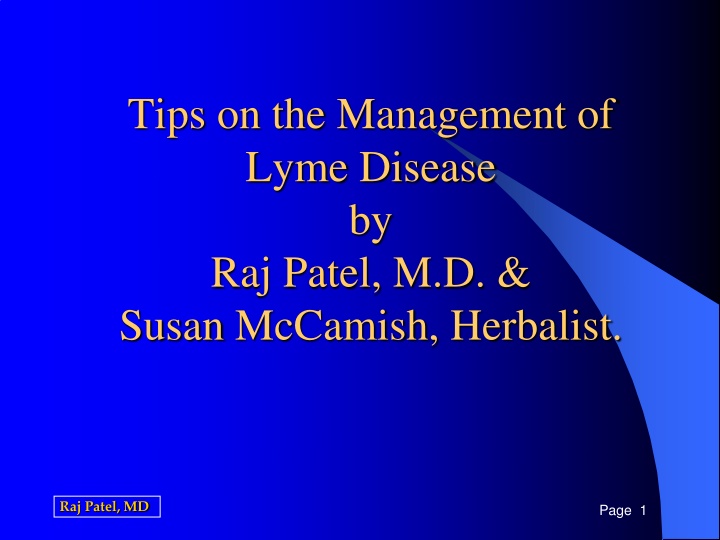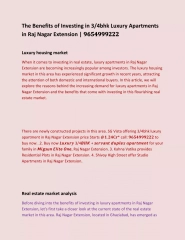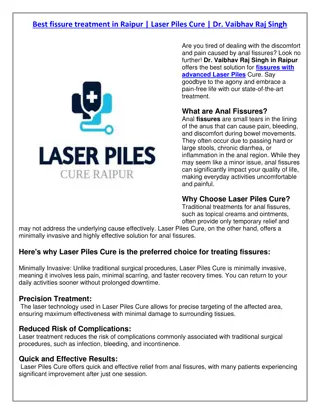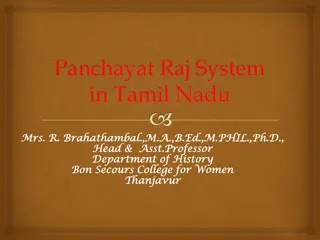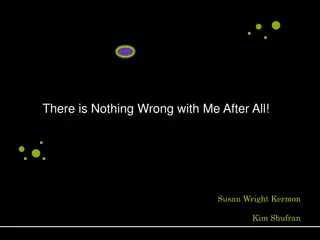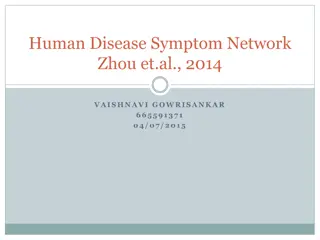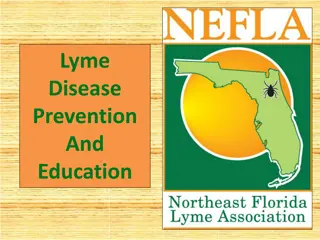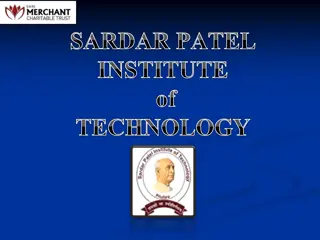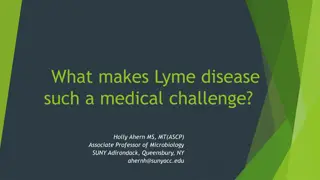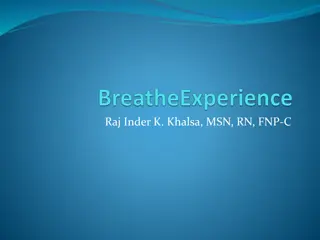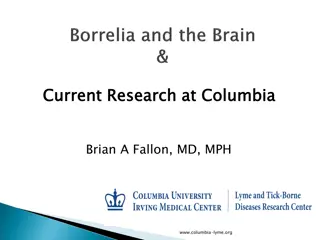Comprehensive Management Tips for Lyme Disease by Raj Patel, M.D. & Susan McCamish, Herbalist
Raj Patel, M.D., along with herbalist Susan McCamish, provides valuable insights on Lyme disease management. The presentation covers aspects such as Jarisch-Herxheimer Reaction, prevalence, symptoms, treatment protocols, and immune response variability. Dr. Patel emphasizes assessing, supporting key organs, and prioritizing microbial treatment. The content includes descriptions of the Jarisch-Herxheimer reaction, its definition, prevalence, and associated symptoms. It also touches upon the importance of discussing treatment options with healthcare providers.
Download Presentation

Please find below an Image/Link to download the presentation.
The content on the website is provided AS IS for your information and personal use only. It may not be sold, licensed, or shared on other websites without obtaining consent from the author.If you encounter any issues during the download, it is possible that the publisher has removed the file from their server.
You are allowed to download the files provided on this website for personal or commercial use, subject to the condition that they are used lawfully. All files are the property of their respective owners.
The content on the website is provided AS IS for your information and personal use only. It may not be sold, licensed, or shared on other websites without obtaining consent from the author.
E N D
Presentation Transcript
Tips on the Management of Lyme Disease by Raj Patel, M.D. & Susan McCamish, Herbalist. Raj Patel, MD Page 1
Raj Patel, MD Education: MS-Rutgers University MD Robert Wood Johnson Medical School Residency-Family Medicine Post Graduate studies in Autism Spectrum Disorders & Lyme Disease Research: Ampligen-CFIDS (Hemispherx Pharmaceutical) Clinical: 20+ years clinical experience Active member of Defeat Autism Now (DAN) 1998-2011 Active member of International Lyme and Associated Diseases Society (ILADS) Raj Patel, MD Medical Options for Wellness 570 Price Avenue, #200 Redwood City, CA 94063 650-474-2130 http://www.DrRajPatel.net Raj Patel, MD Page 2
DISCLAIMER This presentation contains treatment tips for Lyme disease. It is not intended to serve as medical advice. Please discuss potential treatment options with your health care provider. I have no financial arrangements with the various nutritional companies whose products are mentioned in this presentation beyond the resale of these products in my office. Raj Patel, M.D.
Tips on the Management of Lyme Disease Overview: Jarisch-Herxheimer Reaction Definition Prevalence Mechanism Symptoms Laboratory Markers Prevention/Treatment Variable Immune Response Treatment Protocols Foundation Assess & Support Key Organs Evaluate, Prioritize, & Treat Microbes Raj Patel, M.D.
Jarisch-Herxheimer Reaction Raj Patel, M.D.
Jarisch-Herxheimer Reaction (JHR) Definition: Syndrome brought on by the lysis of certain organisms in the body. Symptoms may include fevers/chills, tachycardia, myalgias, headaches and hypotension among others. Jarisch-Herxheimer reaction. Br Med J 1967;1:384. Vaughan C, Cronin CC, Walsh EK, Whelton M. The Jarisch-Herxheimer reaction in leptospirosis. Postgrad Med J 1994;70:118-121 Morrison, DC, et.al.: The effects of bacterial endotoxins on host mediation systems. Amer Jrnl Path 93: 526, 1978. Raj Patel, M.D.
Jarisch-Herxheimer Reaction (JHR) Prevalence: JHR originally reported in association with syphilis treatment. More recently also found with other spirochetal organisms including borrelia. Reported in non spirochetal infections such as Brucellosis, Anthrax and Leprosy. Estimates range 50 75% in Lyme and tick borne diseases. Study on tick borne relapsing fever in US and Canada, JHR reported in only 54.1% of 61 cases. Strominger MB1, et al. J. Neuroophthalmol. 1994 Jun;14(2):77-80. Coxon RE1, et al. The effect of antibody against TNF alpha on cytokine response in Jarisch-Herxheimer reactions of louse-borne relapsing fever. QJM. 1997 Mar;90(3):213-21. Primary author unknown: The Herxheimer Effect, Supplement to the Art of Getting Well. The Arthritis Trust of America: 370, 1991. Dworkin MS1, et al. Tick-borne relapsing fever in the northwestern United States and southwestern Canada. (Clin Infect Dis. 1998 Jan;26(1):122-31. Raj Patel, M.D.
Jarisch-Herxheimer Reaction (JHR) Mechanism: Studies suggest the release of endotoxin like material triggering production of cytokines resulting in symptoms of JHR. There is a 3-20 fold release of endotoxins as a result of antibiotic action on gram negative bacteria, both in vivo and in vitro. Pound MW1, et al. Proposed mechanisms and preventative options of Jarisch-Herxheimer reactions. J Clin Pharm Ther. 2005 Jun;30(3):291-5. Clin Infect Dis. 1992 Nov;15(5):840-54. Antibiotic-induced release of endotoxins: a reappraisal. Hurley JC. Raj Patel, M.D.
Jarisch-Herxheimer Reaction (JHR) Symptoms: Vary widely. May include the following: Low grade fevers Encephalopathy Arthralgias Myalgias Headaches Strominger MB1, et al. Transient worsening of optic neuropathy as a sequel of the Jarisch-Herxheimer reaction in the treatment of Lyme disease. J Neuroophthalmol. 1994 Jun;14(2):77-80. Non convulsive seizures Hepatoxicity Bells Palsy Worsening radiculomyelitis Decrease visual acuity Negussie Y1, et al. Detection of plasma tumor necrosis factor, interleukins 6, and8 during the Jarisch-Herxheimer Reaction of relapsing fever. J Exp Med. 1992 May 1;175(5):1207-12. Berger EM1, et al. Unilateral facial paralysis after treatment of secondary syphilis. J Drugs Dermatol. 2008 Jun;7(6):583-5. Kojan S1, et al. Nonconvulsive status epilepticus resulting from Jarisch-Herxheimer reaction in a patient with neurosyphilis. Clin Electroencephalogr. 2000 Jul;31(3):138-40. Rishi P1, et al. Inhibition of endotoxin-induced hepatotoxicity by melatonininr ats. Int J Biomed Sci. 2008 Jun;4(2):103-12. Raj Patel, M.D.
Jarisch-Herxheimer Reaction (JHR) Lab Abnormalities: Study on patients with louse borne relapsing fever (borrelia recurrentis) elevations in TNF, IL-6 and IL-8 at baseline with levels rising 7, 6 & 4 fold respectively with treatment. 82% of patients in study experienced JHR symptoms. (18% did not?) CSF analysis in neurosyphilis patients during JHR found marked elevations in IL-8 with more moderate increases in IL-10 and IL-15 J Exp Med. 1992 May 1;175(5):1207-12. Negussie Y1, Remick DG, DeForge LE, Kunkel SL, Eynon A, Griffin GE. JAMA Neurol. 2013 Aug;70(8):1060-4. doi: 10.1001/jamaneurol.2013.2120. Davis LE1, Oyer R, Beckham JD, Tyler KL. Raj Patel, M.D.
Jarisch-Herxheimer Reaction (JHR) Prevention/Treatment: Several studies have shown inhibition of JHR after penicillin treatment using TNF antibodies. However, the potential toxicity of clinically available TNF inhibitors like Etanercept (Enbril) make this impractical. QJM. 1997 Mar; 90(3):213-21. The effect of antibody against TNF alpha on cytokine response in Jarisch-Herxheimer reactions of louse-borne relapsing fever. Coxon RE1, Fekade D, Knox K, Hussein K, Melka A, Daniel A, Griffin GG, Warrell DA. N Engl J Med. 1996 Aug 1; 335(5):311-5. Prevention of Jarisch-Herxheimer reactions by treatmentwith antibodies against tumor necrosis factor alpha. Fekade D1, Knox K, Hussein K, Melka A, Lalloo DG, Coxon RE, Warrell DA. Raj Patel, M.D.
Jarisch-Herxheimer Reaction (JHR) Prevention/Treatment: (continued) Steroids have been used with some benefit in reducing JHR. Bacterial endotoxin induced hepatotoxicity ( ALT/AST) was found to be significantly attenuated by melatonin administered pre and post endotoxin challenge in rats. Corresponding depletions in antioxidants were also found to be attenuated by melatonin. S. Ma Y, Weis JJ ((1993) Outer surface lipoproteins OspA and OSP B posess B-cell mitogenic and cytokine-stimulatory properties. Infect Immun. 61:3843-3853. Rev Neurol. 2000 Dec 1-15;31(11):1066-70. HLA and multiple sclerosis. Studies of a Spanish population. Pound MW, May DB. Proposed mechanisms and preventative options of Jarisch-Herxheimer reactions. J Clin Pharm Ther 2005;30:291-295 Int J Biomed Sci. 2008 Jun;4(2):103-12.Inhibition of endotoxin-induced hepatotoxicity by melatonin in rats. Rishi P1, Bharrhan S, Bhalla MP, Koul A, Chopra K. Raj Patel, M.D.
Jarisch-Herxheimer Reaction (JHR) Variable Immune Response: JHR is not consistently seen with studies showing 18-45% of cases with spirochetal infections do not experience JHR to antimicrobials. Inflammatory immune responses can be debilitating and vary dramatically having significant clinical implications on individual case management and the long term potential for a successful outcome. J Exp Med. 1992 May 1;175(5):1207-12. Detection of plasma tumor necrosis factor, interleukins 6, and8 during the Jarisch-Herxheimer Reaction of relapsing fever. Negussie Y1, Remick DG, DeForge LE, Kunkel SL, Eynon A, Griffin GE. Clin Infect Dis. 1998 Jan;26(1):122-31. Tick-borne relapsing fever in thenorthwestern United States and southwestern Canada. Dworkin MS1, Anderson DE Jr, Schwan TG, Shoemaker PC, Banerjee SN, Kassen BO, Burgdorfer W. Raj Patel, M.D.
Jarisch-Herxheimer Reaction (JHR) Variable Immune Response: HLA DR genes: Extensive documentation in the literature linking to various illnesses including celiac, ADHD, Rheumatoid Arthritis and MS among others. HLA DRB/DQ genes: Shoemaker identified specific combinations of subsets of these genes associated with a defect in antigen presentation (specifically borrelial antigens) by dendritic cells to native T cells. These cases were identified as Lyme Susceptible correlated with high C4a responses. Raj Patel, M.D.
Jarisch-Herxheimer Reaction (JHR) Variable Immune Response: Shoemaker in his private practice finds approximately 22% of cases are Lyme susceptible. Informal study in my office of 64 randomly chosen Lyme disease cases. 55 (86%) were found to have at least one allele that was either Lyme susceptible or Multisusceptible . Raj Patel, M.D.
Jarisch-Herxheimer Reaction (JHR) Variable Immune Response: Personal observation: Individuals not carrying a Lyme susceptible or Multisusceptible allele tend to recover faster from Lyme Disease, have minimal JHR symptoms, & need much shorter duration of antimicrobial treatment. This variable immune response may shed light on the ongoing controversy in the medical community regarding length of treatment required to completely recover from borrelia infection. Obviously further studies are needed to clarify the true incidence of Lyme susceptible HLA DR/DQ genes in the general population and the variable inflammatory response to treatment. Raj Patel, M.D.
Jarisch-Herxheimer Reaction (JHR) Variable Immune Response: Soloski s group published a paper on cytokine immune response in acute Lyme disease versus controls. Wide range of immune mediators and acute phase markers were studied. The study revealed 2 distinct response groups. Soloski, Mark et al. Serum Inflammatory Mediators as Markers of Human Lyme Disease Activity. PLOS.org April 2014, Vol. 9, Issue 4. Raj Patel, M.D.
Raj Patel, MD Page 18
Jarisch-Herxheimer Reaction (JHR) Variable Immune Response: Summary: The high mediator group displayed: - more severe symptoms - higher Ab levels - higher rates of sero-conversion post treatment - higher incidence of liver enzyme elevations - lower lymphocyte levels at baseline The low mediator group failed to mount a vigorous immune response leading to speculations to why Lyme symptoms persist in some individuals post treatment. Raj Patel, M.D.
Raj Patel, MD Page 20
Jarisch-Herxheimer Reaction (JHR) Take Home Message: LD cases vary widely in their baseline immune status, levels of inflammation, and response to antimicrobial therapy. Treat each patient individually in terms of the length of treatment, providing appropriate drainage, anti inflammatory and immune support as needed. Raj Patel, M.D.
TreatmentProtocols Raj Patel, M.D.
Treatment Protocols Goals: Treat each case individually. Provide appropriate support to minimize needless pain and discomfort during treatment. Thus allowing the treatment to progress in an efficient and consistent manner. Outline: Foundation Assess and support key organs. Evaluate, prioritize, & treat microbial load. Raj Patel, M.D.
Treatment Protocols A. Foundation: 1. Diet GFCFSF (Gluten Free, Casein Free, Sugar Free) SCD/Paleo Antinflammatory Diet Benefits: Manages gut inflammation Reduces gut dysbiosis Prolongs the effectiveness of the treatment Eliminate alcohol and reduce caffeine. Benefits: Reduces hepatic stress. Raj Patel, M.D.
Raj Patel, MD Page 25
Treatment Protocols A. Foundation: (continued) 2. Sleep Ensure adequate, restful sleep (8-10 hours) Sleep Aids (non Rx): Melatonin Theanine Phosphatidylserine Benadryl Valerian, Kava Kava Sleep Aids (Rx): Benzodiazepines (Halcion, Restoril, Ativan) Tricyclics (Trazadone, Amitriptyline,Nortriptyline) GABA meds (Ambien,Lunesta,Sonata) Anti Seizure (Lyrica,Gabapentin) Raj Patel, M.D.
Treatment Protocols A. Foundation: (continued) 3. Exercise: Gentle as tolerated, daily Helps mobilize lymph/toxins - improves oxygenation and mitochondrial function Ramp up as recovery progresses Adequate fluid intake (8-10 glasses/day) Raj Patel, M.D.
Treatment Protocols A. Foundation: (continued) 4. Safe Environment: Mold/Water Damage: ERMI C4a HLA DRB/DQ Urine Mycotoxin EMFs: Cordless phones Wireless routers Raj Patel, M.D.
Treatment Protocols B. Assess and Support Key Organs 1. Liver/Gallbladder: a. Clues Elevated LFT (elevated total bilirubin indicate GB stress) History (f.f. intol., light greasy stools, ETOH /drug abuse) Food intolerances Waking up between 11-1 am (GB) or 1-3 am (Liver) Caffeine intolerance (Phase 1) b. Support Nutritional support of Phase I or Phase II Silymarin (liver) / bupleureum (GB) Liver Life Glutathione ApoHepat/Mundipur Cholestyramine Consider GB flush / Coffee enemas Raj Patel, M.D.
Treatment Protocols B. Assess and Support Key Organs 2. GI: a. Clues Food intolerance (low BS symptoms between meals) Physical exam (periumbilical discomfort on palpatation) Diarrhea &/or Constipation Borrelia & Viruses (HHV6) b. Support Digestive enzymes Probiotics Antifungals Eliminate refined carbohydrates Reduce complex carbohydrates Consider anti inflammatory diet Binders (CSM, charcoal, clay, bamboo) Treat constipation Raj Patel, M.D.
Treatment Protocols B. Assess and Support Key Organs 3. Immune System/Inflammation: a. Clues Low total IgG/NK cells Elevated C4a Elevated CRP/ESR/TNF Autoimmune markers Joint tenderness on PE b. Support Immune globulins/TF/AHCC/Probiotics/Colostrum CSM (r/o WBD) Low dose antivirals Homeopathics (Inflammayer, Mundipur, A-Inflam) Herbal (Chinese Skullcap, Cyflacalm) NSAIDS? Raj Patel, M.D.
Treatment Protocols B. Assess and Support Key Organs 4. Kidney: a. Clues Elevated or high normal Creat. Proteinuria/ GFR Back/Flank pain b. Support Ensure adequate fluid intake and regular exercise Homeopathics (K-Drain, Renelix) Herbal (Dandelion, Parsley) Raj Patel, M.D.
Treatment Protocols B. Assess and Support Key Organs 5. Endocrine (Adrenals & Thyroid): a. Clues Check blood for TSH, Free T3, Free T4, Reverse T3 Hypothyroid symptoms Saliva cortisol (24 Hour) Symptoms of POTS Inability to tolerate stress b. Support Adequate T4/T3 supplementation Consider Iodine and other nutrient deficiencies Adrenal Support REST Raj Patel, M.D.
Treatment Protocols B. Assess and Support Key Organs 6. Lymph/ECM a. Clues Rings get tight on fingers Feeling stiff/sore in morning or after sitting for 1-2 hours Lack of daily exercise/Sedentary lifestyle Almost universally support needed b. Support Ensure 60-80 oz. of fluid per day Avoid caffeine (diuretic) Regular exercise (20-30 minute walk BID ideal) Homeopathics (Itires, L-Drain, Lymphtone II, etc.) Skin brushing, Lymphatic massage. Raj Patel, M.D.
Treatment Protocols C. Evaluate, Prioritize & Treat Microbial Load 1. Evaluation: Parasites - Stool testing (Genova, DD, DiagnosTechs, & ParaWellnessResearch.) History of extensive foreign travel Symptoms of rectal itching/teeth grinding at night Elevated eosinophil count Consider AK or EST Babesia - Titers, FISH, malaria smear. Symptoms of air hunger, night sweats, severe fatigue, dull global HA, hypercoagulable states Raj Patel, M.D.
Treatment Protocols C. Evaluate, Prioritize & Treat Microbial Load 1. Assessment: Bartonella - Titers (for henselae and quintana) & FISH. (IgenX, Galaxy Diagnostics, Frye labs) Symptoms of anxiety, pseudoseizures, sore soles, irritability, hyperpigmented striae, lymphadenopathy Ehrlichia/Anaplasma - Titers, low WBC count, low platelets, elevated LFTs. Symptoms of knifelike headaches Borrelia - Titers (burgdorferi and hermsii), PCR, culture Symptoms of migratory arthralgias /arthritis, occipital HA, EM rash, multi-system involvement, 4 week cycle Raj Patel, M.D.
Treatment Protocols C. Evaluate, Prioritize & Treat Microbial Load 1. Assessment: Stealth Pathogens (Chlamydia pneum. & trach., Mycoplasma pneum.) - Titers & PCR Viruses - Titers, EBV/CMV/Parvo/HHV6, Lymphocytosis, adenosine, SAM Raj Patel, M.D.
Treatment Protocols C. Evaluate, Prioritize & Treat Microbial Load 2. Prioritize: Parasites Babesia/Bartonella Ehrlichia/Anaplasma Borrelia Stealth Pathogens Viruses Raj Patel, M.D.
Treatment Protocols C. Evaluate, Prioritize & Treat Microbial Load 3. Treatment: I. Parasites Protozoans- Flagyl, Tindamax, Yodoxin, Alinia Consider MC-PZ Helminths & Nematodes Albendazole/Praziquantel x 2 wks + Ivermectin/Mebendazole on days 12-14. 2 3 cycles typically necessary Also Alinia, Humatin, Pyrantel effective. Consider Parazomin, AromaTab, Paratrex, & DE Raj Patel, M.D.
Treatment Protocols C. Evaluate, Prioritize & Treat Microbial Load 2. Treatment: II. Babesia Mepron/Macrolide/Artemesinin Septra/Macrolide Lariam/Plaquenil CoArtem + Artemesinin Consider Bab1 & Bab 2, CryptoPlus, A-Bab, Enula, Artemesinin Raj Patel, M.D.
Treatment Protocols C. Evaluate, Prioritize & Treat Microbial Load 2. Treatment: III. Bartonella Quinolones +/- Rifampin Bactrim + Zithromax +/- Rifampin Doxy + Rifampin Bar 1&2, Houttuynia, A-Bart Raj Patel, M.D.
Treatment Protocols C. Evaluate, Prioritize & Treat Microbial Load 2. Treatment: IV. Ehrlichia/Anaplasma Doxy + Macrolide Doxy + Rifampin Doxy + Quinolone Bb1&2, AL Complex Raj Patel, M.D.
Treatment Protocols C. Evaluate, Prioritize & Treat Microbial Load 2. Treatment: V. Borrelia Doxy + Macrolide + Plaquenil PCN/Ceph + Macrolide + Plaquenil Septra + Macrolide + Plaquenil Consider Bb1&2, A-L Complex, Samento & Banderol Raj Patel, M.D.
Treatment Protocols C. Evaluate, Prioritize & Treat Microbial Load 2. Treatment: VI. Chlamydia Doxy + Macrolide +/- Rifampin Doxy + Quinolone Consider Bar 2, A-Cpn Raj Patel, M.D.
Treatment Protocols C. Evaluate, Prioritize & Treat Microbial Load 2. Treatment: VII. Mycoplasma Rifampin + Macrolide Doxy + Quinolone Bactrim + Macrolide Consider A-Myco, ENL-MC Raj Patel, M.D.
Treatment Protocols C. Evaluate, Prioritize & Treat Microbial Load 2. Treatment: VIII. Viruses Famvir / Valtrex / Valcyte Consider IMNV & IMNV2, AEBH6, Viralox or IRM. Supplement Glutathione & Vit. D as needed. Remember binders and detox support. Consider GcMAF (for elevated Nagalase) Raj Patel, M.D.
Take Home Message 1. Manage Inflammation (diet, genetics, infections) 2. Support elimination of biotoxins 3. Treat underlying infections at a rate that does not overwhelm #1 & 2 4. Look for unrecognized sources of inflammation (mold!) 5. Be on the lookout for underlying emotional/lifestyle issues that may jeopardize healing Raj Patel, M.D.
THANK YOU Raj Patel, MD Page 48
